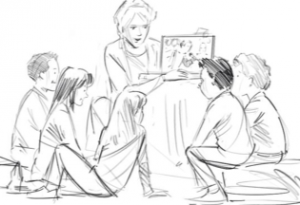Collaborative media project
Designed into these learning stories:
Narrative
Students are set open projects involving experts to develop research skills as well as developing subject knowledge in areas in which they are interested. They are also involved in developing a rubric for content and assessment with the teacher and experts to further enhance understanding.
Mr Walker’s class has been tasked with an open project to create a short media production to convey a message based on an important issue. By undertaking this project, Mr Walker hopes to develop the students’ research and production skills as well as support them in developing subject knowledge in areas in which they are interested.
Helen is very passionate about architecture and after a discussion with Mr Walker, she decides to produce a piece of media to highlight how various world cities demonstrate their history and environment. Mr Walker then challenges her to identify a purpose in what she is doing and to ensure her product has a suitable audience and purpose. After group discussion about the benefits of using different types of digital media, Helen decides to produce five short digital videos, each focusing on a different city and each aiming to cause the audience to reflect on what shapes their home town.
Helen and Mr Walker then begin to work with a local town planner, who acts as expert, to co-develop assessment criteria for her project in the form of a rubric. The rubric is developed to ensure that Helen can be clear about what would make a good subject-based video and builds on the national guidelines in geography and history. The rubric is developed with input from Mr Walker, the local expert, and Helen into what would make a powerful video that could convey a challenging narrative to the audience. Once the rubric is finalised and Helen can explain the component parts of what is required, the production process begins.
As Helen is creating storyboards and beginning to record the films, Mr Walker has real time access to Helen’s progress which he can monitor through the school Virtual Learning Environment (VLE). By providing iterative feedback to Helen based on her progress, they add further detail to the rubric to create a detailed picture of what success will look like for Helen’s work. Mr Walker is aware that by co-designing the assessment rubric in this way, Helen is developing a greater understanding of the subject content, as well as an understanding of film production and story-telling. Further, Mr Walker invites community experts in to add to the rubric, to support Helen’s own project, but also to ensure that the school builds on the expertise of the community.
At the end of the development process, Helen presents her videos at the end of the school day to an audience of teachers, peers, the conservation expert and members of the local community. During the presentation Helen provides a live commentary answering questions from an audience and hears, first hand, their feedback on the videos, the content and the overall message. As part of her own self-assessment, Helen then makes notes against the assessment rubric, whilst Mr Walker collates the audiences’ feedback for their next student- teacher tutorial.
This post is also available in: Turkish









